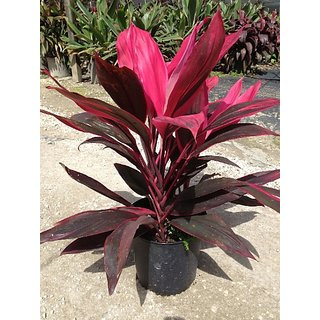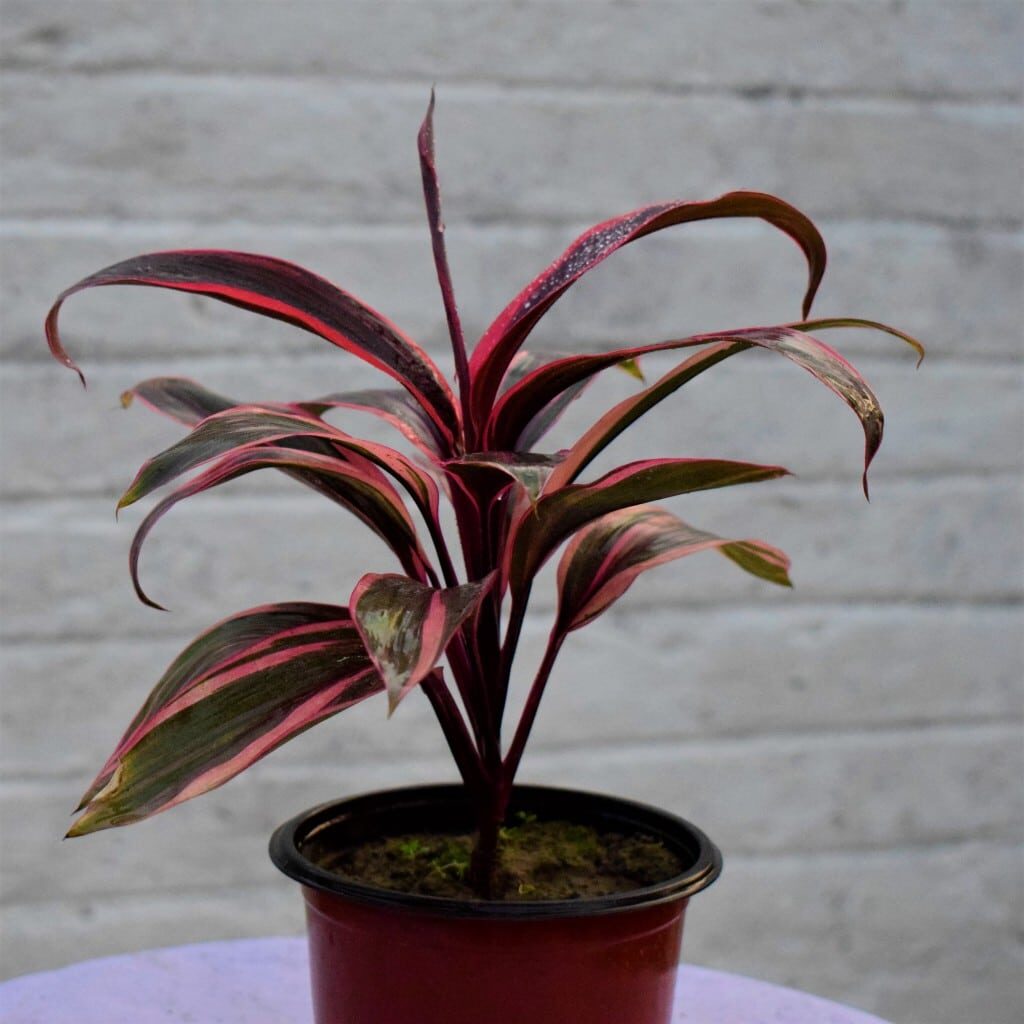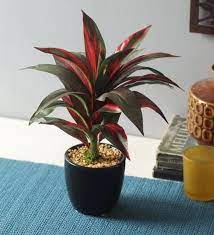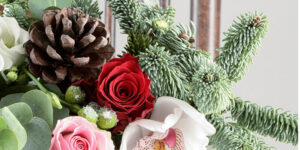Red -Edged Dracaena Plant

The popular houseplant dracaena Plant reflexes have its roots in Madagascar and other islands in the Indian Ocean. Plants of the genus Dracaena get their name from the ancient Greek word dracaena, which means “female dragon,” because of the red gum-like resin found in their stems. This resin has been used for dental hygiene, coloring, and medical purposes for centuries. The processes of varnishing and photoengraving also rely on it nowadays. Song of India and Plumule are other names for the dracaena plant.
Dracaena plants require little attention and can even tolerate some neglect. The best part is that dracaenas aid in cleaning the air we breathe.
NASA has ranked the Red Edged Dracaena Plant, often known as the Madagascar Dragon Tree, as one of the top 10 best plants for purifying the air. This incredible all-natural product does more than just increase the oxygen levels in your home. Toxins, carcinogens, and irritants like benzene, formaldehyde, trichloroethylene, xylene, and toluene are all filtered out and eliminated. If you’re concerned about exposure to the chemical compounds thought to cause Sick Building Syndrome, consider purchasing a Dracaena plant for each of your indoor spaces.
It’s hard to imagine a common houseplant like the Red Edged Dracaena having the power to reduce your risk of cancer, asthma, allergies, autoimmune disorders, and other diseases, yet it accomplishes just that by filtering out hazardous chemicals. Purification at its finest One plant per 100 square feet of floor space is what NASA suggests.
The appearance of this plant is bright and tropical. The prickly, variegated leaves are green, yellow, and pinkish-red at the edges. These clusters of vibrant foliage are supported by canes that are reminiscent of bamboo and give the garden an exotic Asian feel. Large dracaenas rarely make it over 6 ft. in height and 3 ft. in width when kept indoors, despite their potential.
The Dracaena Plant is an easy-care houseplant to keep. When the soil starts to get dry, that’s when you give it a good soaking. This plant is adaptable and may thrive in dim lighting, although it does best in medium to bright-filtered light. When deciding where to put your Red Dragon plant, take in mind that the color will be brighter in bright light and fade in low light.
Our slow-release, balanced fertilizer should be used twice yearly for optimal development. This plant can be planted outside as a patio plant but needs some protection from the sun. It will need to be handled as an annual or moved in before temps dip below about 50 degrees. Outdoor dracaena cultivation is possible in USDA hardiness zones 10 and 11.
An Overview of Dracaena Plant
Whether you live in a subtropical environment or not, you can find dracaena plant everywhere from your living room to your garden. The indoor version of this tree can grow to a height of three feet and looks like a bushy tree. Its lustrous leaves may reach a length of a foot and a width of four or five inches.
About 40 species belong to the genus dracaena plant, which is part of the asparagus family (Asparagaceae). The yellow-edged Variegata cultivar known as Song of India is by far the most well-liked choice. The secondary thickening meristem seen in dracaena plant is a fascinating anatomical feature (the tissue which helps plants grow). Its large, thick, and succulent roots are the result of a secondary meristem that also helps the plant produce abundant foliage.
The striking foliage of the dracaena Plant, with its brilliant color patterns, is not only a superb decorative accent but also beneficial to the indoor environment. It is important to routinely wipe the plant’s leaves with a damp cloth, both on the top and bottom, to promote healthy air circulation.
Dracaena plant : Plant Care Varieties
Asclepias Reflexes (Dracaena) Dracaena plant reflex, often called the song of India or people, is the most prevalent dracaena Plant species. The leaves of this plant, which is one of the most eye-catching houseplants, are what make it so special. The slender, pointed leaves of this houseplant are striped with bright yellow so you can’t miss them. This versatile houseplant does well in either indirect sunlight (as in a sunny window) or partial shade (as on a patio).
How to Take Care of a Dracaena
Marginata Dracaena In ideal conditions, the evergreen Dracaena marginata (also known as red-edge dracaena or Madagascar dragon tree) can reach a height of eight to fifteen feet and a width of three to eight feet. It features trunks that are thin and curved, with rigid leaves and purple-red color. It’s typically grown inside because it’s sensitive to both low light and frost. They are among the more forgiving dracaena plants and can survive in low water conditions, making them ideal houseplants.
Dracaena Plant Maintenance
the dracaena plant massaging The mass cane, also known as Dracaena Plant messaging or Dracaena plant fragrans messaging, is a popular houseplant. It’s the least expensive of the dracaena species, and it’s cheap relative to other houseplants, too. Mass cane has long, strap-like leaves and thick, woody canes. It thrives best in bright, indirect sunlight but may adapt to dim settings. Dracaena messaging is low-maintenance because it grows slowly, remaining in the same spot for years.
Tips on Caring for a Dracaena Plant
These dracaena growing instructions should answer any questions you may have about taking care of this plant. In most cases, dracaena plant require only minimal effort on your part to maintain
Indoor Dracaena Cultivation Tips.

Because of its low maintenance needs and general lack of snob appeal, dracaena Plant makes for a great houseplant.
There is a wide range of environmental circumstances in which the Dracaena plant can thrive. On the other hand, dracaenas Plant require bright indirect light. The optimal conditions for growth are bright, indirect light. Even in low light, dracaena plant can do well, however, its growth will be much slower. To a greater extent than green-leaved variations and species, variegated forms thrive when exposed to bright light and warm temperatures.
Fertilizer
You should fertilize your dracaena every 15 days from April through September, the plant’s growing season. The best fertilizer for ornamental deciduous trees is a complex one, whether it be granular or liquid. After the plant’s dormant period has begun in the fall, it should not be fed.
Temperature
The ideal air temperature throughout the summer is between 18 and 25 degrees Celsius. And even in the dead of winter, temperatures shouldn’t fall below 12 degrees Celsius. The plant can’t grow when the temperature is below 12 degrees Celsius. It can even die on occasion.
Humidity
The plant thrives in high-humidity environments. Add some pebbles to the bottom of the pot to enhance the humidity even further.
Dracaena plant, on average, need watering every two days throughout the summer. More frequent watering is required if the top few centimeters of the substrate are allowed to dry up more quickly. Keep in mind that dracaena thrives in humid environments, so be sure to mist the plant often with water throughout the summer. The water should be at or slightly below room temperature.
Watering less frequently is recommended if the plant is kept in a cool location during the winter. Watering and humidifying will be required even more frequently than in the summer if the space is situated close to functional heating equipment. The plant could die if it gets too dry.
Pruning
Plant proliferation and dracaena pruning go hand in hand. To maintain the dracaena’s aesthetic appeal, it is necessary to prune the plant. One reason for this is that some species, like the Dracaena Fragrant and the Dracaena Marginata, can grow to be many meters in height while producing leaves only towards the top. The plant’s appeal is diminished as a result. Growers remedy this by chopping off the top of the dracaena plant and re-rooting it. Meanwhile, new leaves are growing on the portion of the Dracaena plant that is still contained in the container. So instead of just one lovely plant, you get two! The dracaena can be spread by cutting it back in this way.
Two methods exist for cutting back dracaena plants:
An instance of rooting in cuttings. Cut the trunk of the plant in the shape of a T, standing back a safe distance from the crown. Cover the cut with plastic wrap and a small bit of moistened peat. In around 4 weeks, new roots should start to grow from the incision. Then, stepping down from the new roots, cut off the top using a sharp instrument. The next step is to replant the cutting into a larger container.
Strengthening the foundation by starting at the top. Get a fresh pot and line the bottom with drainage material. After the water has settled, pour the soil into the container. Remove the top 10–15 cm of the dracaena plant trunk using a sterilized, sharp knife. Add some charcoal powder to the wound. Cut it in half, then use Zircon to treat the wound, and finally remove the lower leaves. Put it in a pot with dirt you’ve already prepared. If the upper leaves on the cutting are many or excessively large, reducing them by a third will encourage the plant to produce a strong root system. Paraffin wax should be “poured” over the remaining portion of the stem in the empty pot. If you give it the same care it’s always gotten, in a short while you should see a new shoot emerge from the plant.
Repotting
Only report your dracaena plant when it needs it! (about 1 time in 2 or 3 years). Since the dracaena has a rather shallow root system, it is important to provide a substantial drainage layer at the bottom of the pot to prevent water from pooling. Get some pre-mixed soil that has been formulated for palm plants.
Repotting a dracaena plant entails transferring the plant and all of its soil to a new, larger container if the dirt in the old pot has been used up. After repotting, make sure there is drainage in the bottom of the pot and give the plant plenty of water.
Regardless of the time of year, you can report whenever is most practical for you. Nonetheless, the season of spring is optimal for this surgery. If you’re going to be repotting your plant, you should use freshly boiled water to dampen the new clay container. Then, leave it in water for a while so the clay may absorb the water and expand its pores.
Empty the soil mixture into the planter. The shrub should be transplanted from its current container into the middle of the new one. Fill the container with soil and gently realign the plant’s roots. Don’t forget to give the container the occasional tap on the floor to help the substrate settle and fill up any gaps. When the container is full, press the substrate down gently. Following this, you should water the plant and spray its leaves. Put it somewhere warm and dark. Dracaena plant may become ill after being repotted, but it should recover eventually.
Propagation
Only stem cuttings or apical meristem cuttings can be used for the vegetative propagation of dracaena varieties with variegated foliage. Green-leaved plants can spread their genes both vegetatively and through seeds.
In the “Pruning” section, I went into length on dracaena apical cutting propagation. Plant the cut apical stem in water first if you’re nervous about putting it in the soil. Plant the cutting once it has developed roots.
How to Germinate a Dracaena Plant
Plant dracaena plant seeds in damp soil instead of cutting them. It takes about 30–40 days for the seeds to begin sprouting, depending on the type of dracaena plant and the environment in which you plan to cultivate it. Soaking them in warm water for about five days is advised to enhance germination. Keep in mind that you need to replace the water every day. Once a plant reaches a height of 5 to 6 centimeters, it is ready to be transferred to a larger, more permanent pot.
It is possible to propagate dracaena using cuttings.
If you don’t have any dracaena plant seeds, you can easily grow new plants from cuttings. To propagate dracaena plant, just take cuttings that are six to eight inches long and replant them in new containers. Keep the soil around a cutting wet and make sure around 2/3 of the cutting is above ground.
Typically, it takes a few months for new growth to become apparent.
Insert the plant (cutting) into the potting mix in a container with drainage holes.
Find somewhere light but not too sunny. These plants cannot survive in cool environments.
To remove excess water from a plant (distilled, rain, or day tap)
Successful Dracaena plant Cultivation under Outdoor Conditions
Outdoor Dracaena Plant

The outdoor cultivation of this plant necessitates considerable care. To begin, find a suitable location. No extremes of light or darkness are desirable. Filtered-light areas are preferable. Remember that the plant does best in well-drained soil.
Create a hole there in the ground. It needs to be twice as big as the root of the plant. To easily grow, the root system needs soil all around it. Fill the remaining soil, stamp it down, and repeat as necessary (this will ensure the firmness of the ground).
When caring for a dracaena plant, you should only water it once a week after the first 20 days.
When do Dracaena plant leaves fall off and why?
Too many people are concerned that the plant will perish because its leaves are becoming brown and eventually dying from the tip out. Simply removing the dead branches won’t solve the issue.
Consider the causes that could have produced these outcomes. A common cause of this is that the leaves were either under or over-watered. Well-drained soil should always be used for long-term stability. In addition, you need to ensure sure the pot has good drainage.
Care Instructions for Dracaenas
Maintaining plants properly relies heavily on diligent cultivation. Pruning a dracaena, knowing when to begin transplanting it, and sticking to the care recommendations are all skills that not everyone possesses. This article will serve as your manual for successful plant cultivation.
This plant can survive in a broad variety of environments. The optimal conditions for growth are bright, indirect light. The plant will survive in low light, but its growth will be much more sluggish. There is a wide range of environmental circumstances in which the Dracaena plant can thrive. On the other hand, dracaena plant require bright indirect light. The optimal conditions for growth are bright, indirect light. Even in low light, dracaena plant can do well, however, its growth will be much slower. To a greater extent than green-leaved variations and species, variegated forms thrive when exposed to bright light and warm temperatures.
No matter what time of year it is outdoors, the temperature inside should always be comfortable. At temperatures below 65 degrees Fahrenheit, plant growth is stunted. It can even die on occasion.
Raise the humidity around the plant, and it will flourish. Add some pebbles to the bottom of the pot to enhance the humidity even further.
Fertilizers: such requirements are straightforward. Water-soluble house plant fertilizer can be applied twice monthly during the summer and spring. The fertilizer is unnecessary during the fall and winter months.
Because of their extreme sensitivity to fluoride, these plants should be grown in fluoride-free environments. Because of the prevalence of fluoride in municipal water supplies, it is crucial to drink only filtered or distilled water.
There is a requirement for sunlight.
Ambient Lighting: A site with filtered inside light (from a sheer curtain in front of a sunny window, for example) or partial shadow is perfect. The leaves of a dracaena plant will burn if you put them in direct sunlight.
Water
When compared to other houseplants, dracaenas have a low water requirement. Mist the leaves with water and keep the soil moist (but not saturated) with proper drainage to ensure the plants stay healthy. Before watering, the soil’s surface should always be allowed to dry off. Too much water can damage the roots, so be careful. Dracaena plant needs to be watered often and thoroughly, but only after the top 2–3 cm of the substrate has dried out. Do not let water sit in the soil for long periods when watering dracaena plant, since this may cause the plant to respond very negatively. If you want your plant to thrive, you need to loosen the top layer of the substrate before you water it. You should only use filtered or well-settled water to water the plant.
Not to worry if you see the bottom leaves turning yellow and falling; this could be a sign of over-watering or inadequate drainage. Leave loss in dracaena plants is a natural part of the plant’s life cycle.
Because of their sensitivity to fluoride, which is present in tap water, purified water must be used while watering these plants. Fluoride toxicity may be indicated by dark brown leaf coloration and dead spots with yellow margins.
Temperatures
Dracaena plant grows best in temperatures between 65 and 78 degrees Fahrenheit during the day. Even though the plant can withstand temperatures ten degrees colder at night, it will not survive in temps below 55 degrees Fahrenheit. Be cautious to put your dracaena in a location far from any vents or ventilating devices. Despite its reputation as a tough houseplant, dracaena plant is happiest in the higher humidity of the rainforest where it originated. Humidity can be increased with a commercial humidifier, or you can simply set the plant in a tray of pebbles filled with water up to the stones’ tops.
Toxicity
Cats and dogs might get sick if they ingest anything toxic to them. Both cats and dogs can show signs including dilated pupils, as well as vomiting, excessive salivation, and loss of appetite. Being aware of which plants are toxic to our pets is a vital first step in making an informed decision when shopping for houseplants.
Pests and Concerns: Dracaena plants are generally free from major insect or disease problems. Keep an eye out for mealybugs, spider mites, and scale, though. An insecticide containing pyrethrin is effective against mealybugs and scale.
If you reside in a subtropical climate, you can successfully grow dracaena plant either indoors or out, under partial shade. Now that you know how easy it is to care for a dracaena plant, and are ready to grow one in your own home, check out our extensive selection here.


